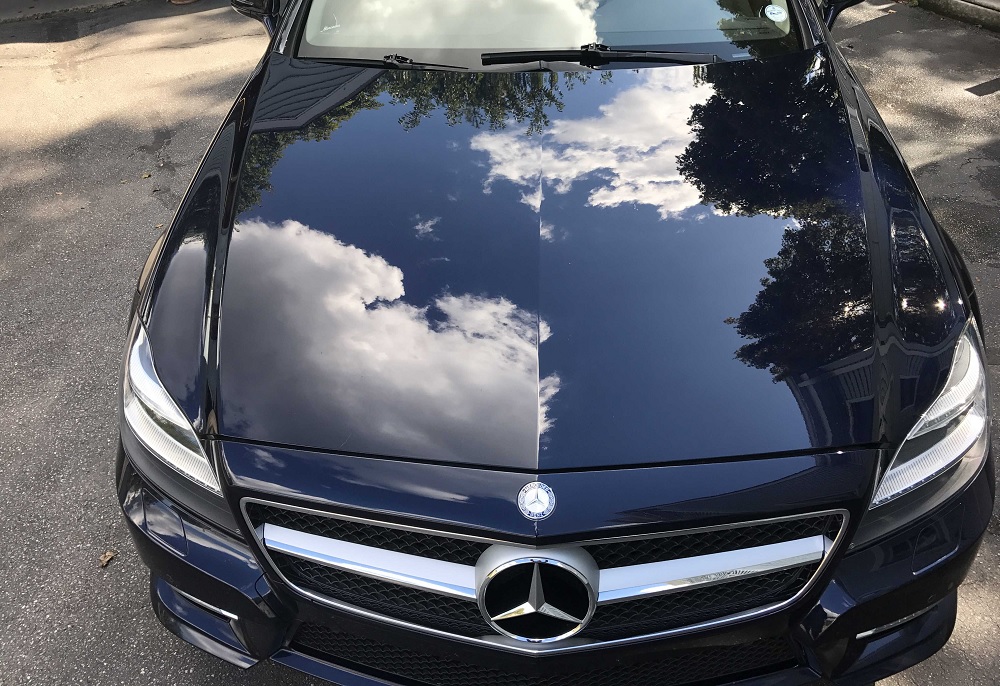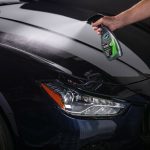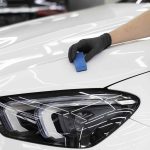In the realm of car care, the application of ceramic coating has become synonymous with protecting and enhancing the aesthetics of vehicles. As car enthusiasts delve into the meticulous world of detailing, questions often arise about the compatibility of various products with ceramic coatings. One common inquiry that echoes through online forums and detailing communities is, “Can you use iron remover on ceramic coating?” In this comprehensive guide, we will not only answer this burning question but also unravel the nuances surrounding ceramic coatings and iron removers.
Table of Contents
- Understanding the Essence of Ceramic Coating
- The Peculiar Iron Remover Dilemma
- Safely Applying Iron Remover on Ceramic Coating
- Common Mistakes to Sidestep
- Benefits Beyond the Surface
- Exploring Additional Considerations
- Expert Tips: Mastering Iron Remover Application on Ceramic Coating
- 1. Choose a High-Quality pH-Balanced Iron Remover
- 2. Perform a Spot Test First
- 3. Invest in a Soft Applicator
- 4. Time Your Application Carefully
- 5. Gentle Agitation for Stubborn Contaminants
- 6. Thorough Rinse is Non-Negotiable
- 7. Avoid Direct Sunlight
- 8. Regular Maintenance is Key
- 9. Mind Your Surroundings
- 10. Moderation is the Golden Rule
- 11. Inspect and Address Promptly
- Elevate Your Detailing Routine
- Frequently Asked Questions: Demystifying Iron Remover Use on Ceramic Coating
- 1. Can I use any iron remover on my ceramic-coated vehicle?
- 2. How often should I apply iron remover on my ceramic coating?
- 3. Is it necessary to perform a spot test before applying iron remover?
- 4. Can I apply iron remover in direct sunlight?
- 5. What happens if the iron remover dries on the surface?
- 6. Can I use abrasive tools with iron remover for tough contaminants?
- 7. Will using iron remover affect the lifespan of my ceramic coating?
- 8. Can I apply iron remover on a newly applied ceramic coating?
- 9. Do I need to rinse my vehicle after applying iron remover?
- 10. Can I use iron remover on other surfaces besides the exterior paint?
- Empowering Your Car Care Knowledge
- Conclusion: Nurturing Your Ceramic Coated Vehicle
Understanding the Essence of Ceramic Coating
To grasp the implications of using iron remover on ceramic coating, it’s essential to first understand the fundamental purpose of ceramic coatings. These liquid polymers, when meticulously applied to a vehicle’s exterior surfaces, forge a chemical bond with the factory paint. The resulting shield acts as a formidable defense against the onslaught of environmental contaminants, ultraviolet (UV) rays, bird droppings, water spots, and more. The longevity and effectiveness of ceramic coatings make them a popular choice for car owners seeking to preserve their investment.
The Peculiar Iron Remover Dilemma
1. Can You Really Use Iron Remover?
The straightforward answer is yes, you can use iron remover on ceramic coating. However, the devil lies in the details. Iron removers are formulated to dissolve iron particles, commonly found in brake dust and industrial fallout, that adhere to surfaces. While these products are generally safe for ceramic coatings, there are crucial caveats to consider to prevent unintended consequences.
2. Best Practices for Using Iron Remover
pH-Balanced Formulas
Selecting a pH-balanced iron remover is paramount. The pH balance ensures that the product is neither too acidic nor too alkaline, safeguarding the delicate equilibrium of the ceramic coating.
Avoiding Strong Acids
Refrain from using iron removers with strong acids, as they can compromise the integrity of the ceramic coating. Opt for products specifically designed for use on coated surfaces.
Manufacturer Guidelines
Always defer to the manufacturer’s guidelines for both the ceramic coating and the iron remover. These guidelines are crafted to maximize the effectiveness of the products while minimizing any potential risks.
Safely Applying Iron Remover on Ceramic Coating
3. Rinse the Vehicle Thoroughly
Initiate the iron removal process by giving your vehicle a thorough rinse. This preliminary step dislodges loose dirt and contaminants, preparing the surface for the subsequent application of the iron remover.
4. Test in a Small Area
Before committing to a full application, conduct a test in a small, inconspicuous area. This precautionary measure allows you to gauge the product’s compatibility with your specific ceramic coating.
5. Applying Iron Remover
Using a soft sponge or applicator, apply the iron remover evenly across the surface. Ensure comprehensive coverage while being mindful not to let the product dry prematurely.
6. Agitating if Necessary
For more stubborn contaminants, a gentle agitation with a soft brush can enhance the iron remover’s efficacy. This step is particularly beneficial for areas with dense iron particle buildup.
7. Rinse Again
After the prescribed dwell time, thoroughly rinse the vehicle to eliminate any residual iron remover. A pristine rinse ensures that the product is entirely removed without leaving behind any residue.
Common Mistakes to Sidestep
8. Using Abrasive Tools
Avoid the temptation of using abrasive tools or pads during the iron remover application. Such tools can potentially mar the surface of the ceramic coating, undermining its protective capabilities.
9. Preventing Drying
Never allow the iron remover, or any cleaning product for that matter, to dry on the surface. Working in shaded areas and dividing the vehicle into manageable sections can prevent premature drying and ensure an effective application.
Benefits Beyond the Surface
10. Enhanced Contaminant Removal
The primary advantage of using iron remover on ceramic coating lies in its ability to dissolve and remove iron particles that regular washing might overlook. These microscopic contaminants, originating from brake dust and industrial fallout, can compromise the glossy finish of a ceramic-coated vehicle.
11. Prolonged Ceramic Coating Lifespan
Routine cleaning with a suitable iron remover contributes to the overall longevity of your ceramic coating. By addressing contaminants promptly, you not only preserve the aesthetic appeal of your vehicle but also extend the lifespan of the protective coating.
Exploring Additional Considerations
Environmental Factors
Environmental factors play a crucial role in the maintenance of ceramic coatings. Vehicles frequently exposed to harsh conditions, such as coastal areas with salt-laden air or regions with high levels of industrial pollutants, may require more frequent applications of iron remover.
Frequency of Application
While iron removers can be a valuable addition to your detailing arsenal, moderation is key. Excessive and unnecessary use may lead to diminishing returns and could potentially harm the coating over time. It’s advisable to follow a regular maintenance schedule while keeping a keen eye on the condition of your ceramic coating.
Expert Tips: Mastering Iron Remover Application on Ceramic Coating
As we delve deeper into the intricate world of maintaining ceramic coatings, the application of iron remover emerges as a pivotal aspect of the detailing process. To elevate your car care game, here are some expert tips that will guide you in mastering the art of using iron remover on ceramic coating.
1. Choose a High-Quality pH-Balanced Iron Remover
Opt for iron removers specifically formulated for use on ceramic coatings. A high-quality, pH-balanced formula ensures effective cleaning without compromising the delicate balance of your coating.
2. Perform a Spot Test First
Before committing to a full application, conduct a spot test in an inconspicuous area. This helps you gauge the product’s compatibility with your specific ceramic coating.
3. Invest in a Soft Applicator
Use a soft sponge or applicator pad to apply the iron remover. This minimizes the risk of scratching the coating and ensures an even distribution of the product.
4. Time Your Application Carefully
Adhere to the recommended dwell time specified by the iron remover manufacturer. Applying the product for the right duration enhances its effectiveness without causing any harm to the ceramic coating.
5. Gentle Agitation for Stubborn Contaminants
For areas with stubborn contaminants, employ a soft brush for gentle agitation. This targeted approach helps loosen and remove persistent iron particles without causing abrasions.
6. Thorough Rinse is Non-Negotiable
After the dwell time, rinse your vehicle thoroughly. Ensure all traces of the iron remover are removed, preventing any potential residue from affecting the ceramic coating.
7. Avoid Direct Sunlight
Choose a shaded area for the iron remover application. Direct sunlight can accelerate drying, reducing the product’s efficacy and potentially causing streaks on the coating.
8. Regular Maintenance is Key
Incorporate iron remover application into your regular maintenance routine. This proactive approach prevents the buildup of iron particles, preserving the integrity and aesthetics of your ceramic coating.
9. Mind Your Surroundings
Consider the environmental conditions your vehicle is exposed to. Areas with high industrial fallout or coastal regions with salt-laden air may require more frequent iron remover applications.
10. Moderation is the Golden Rule
While iron removers are beneficial, moderation is key. Avoid excessive use, as this may lead to diminishing returns and could potentially harm the ceramic coating over time.
11. Inspect and Address Promptly
Regularly inspect your ceramic coating for any signs of deterioration or contamination. Address issues promptly to maintain the longevity of the coating and the overall appearance of your vehicle.
Elevate Your Detailing Routine
By incorporating these expert tips into your detailing routine, you’re not just cleaning your vehicle; you’re elevating the care and maintenance of your ceramic-coated pride and joy. From choosing the right products to mastering application techniques, these insights empower you to navigate the delicate balance between cleanliness and protection. Happy detailing!
Frequently Asked Questions: Demystifying Iron Remover Use on Ceramic Coating
Navigating the intricacies of car care often leads to a plethora of questions, especially when it comes to the application of products like iron removers on ceramic coatings. Let’s demystify the common queries with insightful answers to ensure you approach the process with confidence.
1. Can I use any iron remover on my ceramic-coated vehicle?
Yes, you can use an iron remover, but it’s crucial to choose a product specifically designed for use on ceramic coatings. Opt for pH-balanced formulas to prevent any adverse effects on the coating.
2. How often should I apply iron remover on my ceramic coating?
The frequency of application depends on environmental factors. In areas with high industrial fallout or coastal regions, more frequent applications may be necessary. Generally, incorporating iron remover into your regular maintenance routine is advisable.
3. Is it necessary to perform a spot test before applying iron remover?
Absolutely. Performing a spot test in an inconspicuous area allows you to ensure the compatibility of the iron remover with your specific ceramic coating, preventing any unwanted reactions.
4. Can I apply iron remover in direct sunlight?
It’s not recommended. Choose a shaded area for the application to prevent premature drying, ensuring the iron remover has sufficient dwell time for optimal performance.
5. What happens if the iron remover dries on the surface?
Allowing the iron remover to dry on the surface can lead to streaking and diminished effectiveness. Always work in sections and ensure a thorough rinse to prevent drying.
6. Can I use abrasive tools with iron remover for tough contaminants?
Avoid using abrasive tools, as they can scratch the ceramic coating. Instead, opt for gentle agitation with a soft brush for stubborn contaminants.
7. Will using iron remover affect the lifespan of my ceramic coating?
When used correctly, iron removers can contribute to a longer-lasting ceramic coating by preventing the buildup of iron particles that may compromise the coating’s integrity.
8. Can I apply iron remover on a newly applied ceramic coating?
Check with the ceramic coating manufacturer for specific guidelines. In some cases, there may be a recommended curing period before applying any additional products.
9. Do I need to rinse my vehicle after applying iron remover?
Absolutely. Thoroughly rinsing the vehicle after the iron remover application is crucial to remove any residue and ensure a clean surface.
10. Can I use iron remover on other surfaces besides the exterior paint?
It’s best to consult the manufacturer’s guidelines. While iron removers are generally safe for coated surfaces, using them on other materials like glass or plastic may require specific considerations.
Empowering Your Car Care Knowledge
These FAQs aim to empower you with the knowledge needed to navigate the realm of using iron remover on ceramic coatings. Armed with these insights, you can approach your car care routine with confidence, ensuring your ceramic-coated vehicle maintains its lustrous appearance over time. Happy detailing!
Conclusion: Nurturing Your Ceramic Coated Vehicle
In conclusion, the query, “Can you use iron remover on ceramic coating?” is met with an affirmative response, accompanied by a series of precautions and best practices. When approached with care and adhering to the recommended guidelines, using iron remover becomes a valuable tool in the maintenance of your ceramic-coated vehicle.
As you navigate the intricate landscape of car detailing, remember that each vehicle is unique, and factors such as the type of ceramic coating, environmental conditions, and individual driving habits contribute to the overall care requirements. By incorporating the insights shared in this guide, you embark on a journey to not only preserve but enhance the beauty of your cherished vehicle. In the pursuit of automotive excellence, the synergy between ceramic coatings and iron removers becomes a harmonious dance, ensuring that your ride remains a beacon of gleaming perfection on the open road. Happy detailing!


